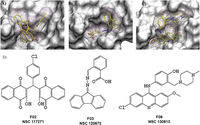Small Molecule Inhibitors of ERCC1-XPF Protein-Protein Interaction Synergize Alkylating Agents in Cancer Cells

Abstract
The benefit of cancer chemotherapy based on alkylating agents is limited because of the action of DNA repair enzymes, which mitigate the damage induced by these agents. The interaction between the proteins ERCC1 and XPF involves two major components of the nucleotide excision repair pathway. Here, novel inhibitors of this interaction were identified by virtual screening based on available structures with use of the National Cancer Institute diversity set and a panel of DrugBank small molecules. Subsequently, experimental validation of the in silico screening was undertaken. Top hits were evaluated on A549 and HCT116 cancer cells. In particular, the compound labeled NSC 130813 [4-[(6-chloro-2-methoxy-9-acridinyl)amino]-2-[(4-methyl-1-piperazinyl)methyl]] was shown to act synergistically with cisplatin and mitomycin C; to increase UVC-mediated cytotoxicity; to modify DNA repair as indicated by the staining of phosphorylated H2AX; and to disrupt interaction between ERCC1 and XPF in cells. In addition, using the Biacore technique, we showed that this compound interacts with the domain of XPF responsible for interaction with ERCC1. This study shows that small molecules targeting the protein-protein interaction of ERCC1 and XPF can be developed to enhance the effects of alkylating agents on cancer cells.
